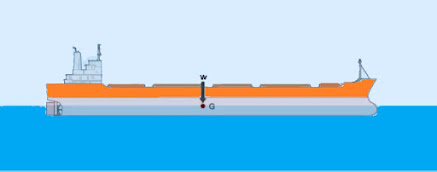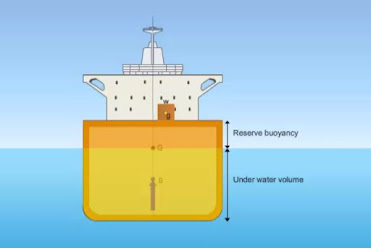Once a ship starts floating, the amount of water displaced is equal to the weight of the ship.
This principle of floatation is known as the law of buoyancy or the law of floatation.According to this law of floatation:
- A body is acted upon by an upward force when it is completely or partially submerged in a fluid; this upward force is equal in magnitude to the volume of fluid displaced by the floating body.
- Imagine a ship placed on the water surface. When the ship is loaded with weights in different locations, concentration of weight is at one point called G.
- The force of gravity acts vertically downwards through this point and is called the center of gravity of a ship. This force is equal to the weight of the ship.
- When the ship floats in water, an upward force acts on the ship, opposing the center of gravity. This force is called the buoyancy force. It is produced by the water around the ship.
- The buoyancy force is equal to the magnitude of the weight of the water, displaced by the ship. This force enables the ship to float.
- Buoyancy B is always at the geometric center of the underwater volume.
- Reserve buoyancy is the intact volume of the ship above the waterline and up to the uppermost continuous deck. It is the space available for displacement when any additional weight is added to the ship.
- Reserve buoyancy is expressed as a volume in cubic meters (or cubic feet).
- The freeboard deck is the uppermost continuous deck. Freeboard is the distance from the freeboard deck to the waterline.
- The freeboard determines the reserved buoyancy.
- If a ship has a large freeboard, it is said to have large reserve buoyancy.
- A ship with a large freeboard can withstand a significant amount of flooding of compartments in case of damage and still remain afloat.
- A ship with a small freeboard can withstand a comparatively small amount of flooding of compartments in case of damage before it sinks.
- The freeboard determines the angle at which the deck edge immerses if the ship is heeled.
- The deck edge of the vessel with a large freeboard will immerse at a relatively large angle of heel.
- A vessel with a small freeboard will ship more seas on deck in heavy weather than a ship with a large freeboard.
- This endangers personnel, deck cargo and deck fittings such as hatchways.
- When the ship tilts to one side, the center of gravity remains the same.
- However, the center of buoyancy shifts from B to B1, as shown, because the underwater volume is more on the heeling side of the ship.
- This buoyancy force acts upwards through the point B1. Metacenter M is the point where the line passing through B1 meets the line passing through 'G'.
- Metacentric height is the distance from the center of gravity to the metacenter. The height of metacenter is the distance from the keel to the metacenter.










Aucun commentaire:
Enregistrer un commentaire